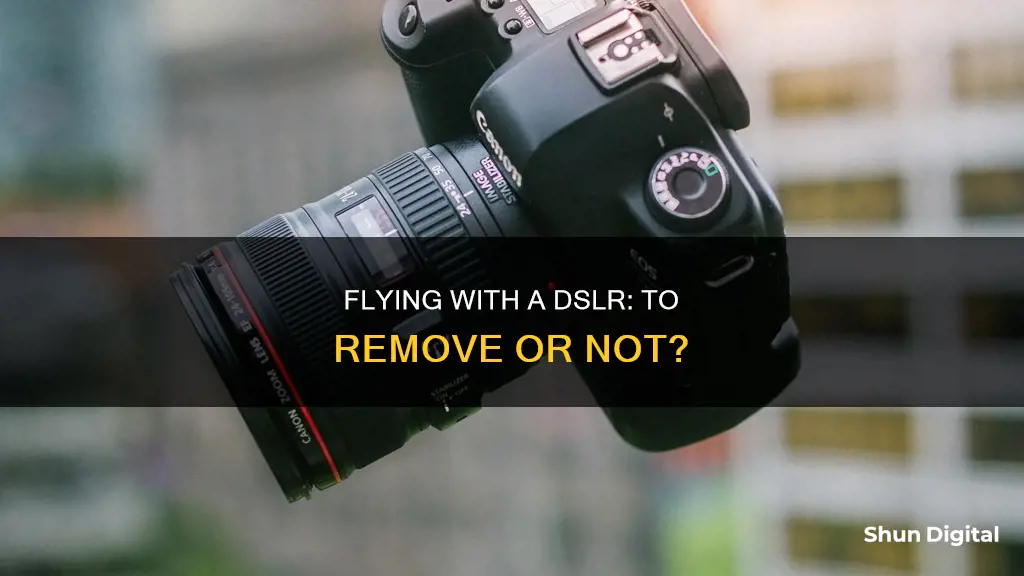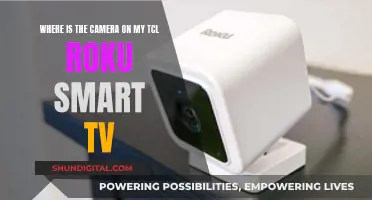
Flying with a camera can be a nerve-wracking experience. The horror stories of lost luggage and the treatment of checked luggage are enough to make any photographer anxious about flying with their equipment. While cameras are allowed on flights, there are some things to keep in mind to ensure your equipment stays safe.
| Characteristics | Values |
|---|---|
| Do you have to remove a DSLR camera from your carry-on bag when flying? | Yes, according to TSA rules, travelers must remove electronics larger than a cell phone, including DSLR cameras, from their carry-on bags and place them in a separate bin for screening. |
| Can you bring a DSLR camera on a flight? | Yes, DSLR cameras are allowed on flights as carry-on or checked luggage, provided they adhere to the airline's size and weight restrictions. |
| Are there any restrictions on carrying DSLR camera batteries? | Lithium-ion batteries, commonly used in DSLR cameras, are permitted in carry-on and checked luggage with special restrictions. Spare lithium-ion batteries must be carried in carry-on luggage and should have protective covers over the terminals. |
| Are there any risks associated with flying with a DSLR camera? | There is a risk of damage or loss when checking DSLR cameras as baggage. It is recommended to carry DSLR cameras in a protective case as carry-on luggage to minimize the risk of damage. |
| Are there any tips for flying with a DSLR camera? | It is advisable to distribute DSLR gear between carry-on and personal items, ensuring the carry-on bag is small enough to fit in the overhead bin. Keep DSLR equipment within sight at all times and consider purchasing a TSA Pre-check pass for expedited security screening. |
What You'll Learn

Packing your DSLR camera
Choose the Right Bag:
Select a bag that is specifically designed for travelling with camera equipment. A good camera bag should be tough, durable, and comply with carry-on restrictions. Look for a bag with reinforced inserts and a tripod holder. Make sure it has enough compartments to keep your gear organised and protected. If you're using a standard backpack, consider purchasing bag dividers to create a separate compartment for your camera.
Keep it Secure:
Always keep your camera bag within sight and never check it in. Carry it onto the plane as hand luggage so that you can keep your valuable gear close by. If you absolutely must check it in, consider purchasing a specialised protective case and ensure you have adequate insurance for your equipment.
Pack it Right:
When packing your DSLR camera, make sure all covers are tight—USB ports, lens caps, battery compartment panel, etc. Don't travel with the lens attached to the camera body, as this can damage the threads that hold the lens. Carry the lens separately, and ensure all lens caps are tightly secured. Remove the battery and memory card, keeping them easily accessible in case you need to prove that the camera is functional.
Be Prepared for Security:
At the security checkpoint, have a good grip on your camera, as you'll likely be juggling multiple items. Place your electrical items in a separate tray to streamline the process. If you're travelling with film, take extra precautions as X-ray imaging can damage it. Keep it in your hand luggage, and consider requesting a manual inspection to skip the X-ray scanning.
Plan for the Unexpected:
Charge your batteries, clean your camera, and select the most suitable lenses for your trip. Be mindful of any liquids, such as lens cleaning solutions, and ensure they are under 100ml and stored in a transparent, resealable bag. Don't forget your battery charger and other essential accessories!
Remember to stay calm, be polite, and give yourself plenty of time at the airport. By following these tips, you can ensure your DSLR camera is well-protected and ready for capturing memorable photos during your travels.
The Privacy Paradox: Cameras in Suicide Watch Cells
You may want to see also

TSA guidelines
The Transportation Security Administration (TSA) does not prohibit photography or filming at security checkpoints. However, travellers are not allowed to interfere with the screening process or reveal sensitive information. Interference with screening includes, but is not limited to, holding a recording device up to the face of a TSA officer, refusing to assume the proper stance during screening, blocking the movement of others through the checkpoint, or refusing to submit a recording device for screening. Additionally, travellers are not permitted to film or take pictures of equipment monitors that are shielded from public view.
According to TSA guidelines, digital cameras can be transported in both carry-on luggage and checked luggage. However, because cameras are fragile items, it is recommended that travellers always pack them in their carry-on luggage. This is because suitcases that go in the hold often get damaged and thrown around in transit, increasing the risk of damage to fragile cameras inside. If possible, travellers should ensure that their camera bag is small enough to fit in the overhead bin or under the seat of the airplane.
TSA officers will typically require travellers to remove electronics larger than a cell phone from their carry-on bags and place them in a bin with nothing on top or below, similar to how laptops are screened. This helps TSA officers obtain a clearer X-ray image. As such, travellers should be prepared to remove their camera from their carry-on luggage and submit it for additional screening if requested.
It is important to note that lithium-ion batteries, which are commonly used in DSLR cameras, are considered hazardous materials and are subject to special restrictions. While these batteries are generally allowed in both carry-on and checked luggage, there are specific guidelines that must be followed to ensure safety. Travellers should always check the latest FAA guidelines and individual airline policies before travelling with lithium-ion batteries.
Finding Your No Man's Sky Camera Photos
You may want to see also

Airline restrictions
Each airline has different rules and regulations for the size and weight of carry-on bags, but generally, your bag should be able to fit in the overhead compartment or under the seat in front of you. A camera backpack is a good option, as wheeled luggage is often required to be left on the jetway. It is also important to keep all items in your carry-on secure, with lenses stored in an insert system to keep them safe. Any straps or attachments, such as tripods, should be secured to avoid getting caught or tangled during transit.
When it comes to batteries, lithium-ion batteries, which are commonly used in DSLR cameras, are considered safe for both carry-on and checked luggage with special restrictions. However, it is important to check the specific guidelines of the airline and FAA to ensure your batteries do not pose a hazard. It is recommended to keep batteries in your carry-on luggage and to pack them securely and separately to avoid contact and short circuits.
Some other items to consider when packing your camera gear include cleaning products, which should be placed in checked luggage due to liquid restrictions. Tripods can be placed in checked luggage as well, as they are not delicate and can take up valuable space in your carry-on. Additionally, you may want to bring extra memory cards and lenses, but be mindful of weight restrictions.
Overall, the key to successfully flying with your DSLR camera is to be prepared, pack carefully, and comply with airline and TSA regulations.
The Japanese Movie 'Don't Stop Camera' is a Must-Watch
You may want to see also

Lithium-ion batteries
When flying with a DSLR camera, it is important to be aware of the regulations surrounding lithium-ion batteries. Lithium-ion batteries are commonly used in DSLR cameras and other electronic devices, and while they are considered safe for air travel, there are some special restrictions to keep in mind.
Firstly, it is important to distinguish between installed and spare batteries. Installed lithium-ion batteries refer to those that are built into a device, such as a camera, laptop, or phone. Spare batteries are those that are uninstalled and separate from a device. The regulations for each type of battery are different.
For installed lithium-ion batteries, the device should be kept in carry-on baggage whenever possible. If it must be packed in checked baggage, ensure that the device is turned off, protected from accidental activation, and packed securely to prevent damage. It is worth noting that some airlines may have specific requirements or restrictions on lithium-ion batteries, so it is always a good idea to check with the airline before travelling.
Spare lithium-ion batteries, on the other hand, have more stringent restrictions. These batteries must always be carried in carry-on baggage and never placed in checked luggage. This is because spare lithium-ion batteries can pose a safety risk if they come into contact with other conductive materials, which could potentially cause a short circuit and lead to a fire. To prevent this, spare batteries should be protected by the manufacturer's packaging or covered with tape to insulate the battery terminals. Additionally, spare batteries should be kept in separate bags to further reduce the risk of short circuits.
It is also important to be mindful of the watt-hour rating of the batteries. Lithium-ion batteries with a rating of 100 watt-hours or less are generally permitted in carry-on baggage. Batteries with a higher watt-hour rating (101-160 Wh) may be allowed with airline approval, but there are usually strict limits on the number of batteries per person.
When travelling with a DSLR camera, it is essential to properly prepare and comply with all relevant regulations. This includes ensuring that batteries are charged and securely packed, following any specific airline guidelines, and being prepared for additional screening at airport security. By taking the necessary precautions, photographers can ensure that their equipment is safe and secure during air travel.
Positioning Your PS VR Camera on a TV
You may want to see also

Camera inspection
When travelling with a camera, it's important to be aware of the relevant rules and regulations, as well as taking steps to ensure your equipment is protected. While policies vary across different countries and airports, here are some guidelines to follow when preparing for camera inspection at airport security:
Packing and Protection:
- Use a dedicated camera bag that is tough, padded, and compliant with carry-on luggage restrictions. Ensure it's easy to lift into the overhead bin if necessary.
- Distribute your gear across your carry-on and personal item bags. Keep your main camera body, a lens, and a flash with you, and place other equipment in the overhead bin.
- Detach the lens from your camera to avoid damage and pack it separately.
- Secure all items within your camera bag to prevent movement during transit. Use an insert system to keep lenses safe.
- Remove large lithium-ion batteries and place them in your carry-on luggage. Other battery types, such as AA batteries, can be left in checked luggage.
- Keep battery terminals protected with insulating tape or the provided protective covers.
- Pack cleaning products and tripods in checked luggage.
- Ensure straps and attachments like tripods are secure and won't get tangled or caught during transit.
- Consider investing in a travel camera backpack to protect your equipment and facilitate easy carrying.
Airport Security:
- Be prepared to remove your camera and other electronics from your carry-on bag and place them in a separate bin for X-ray screening.
- You may be asked to power on your camera, so ensure it's charged before arriving at the airport.
- In some countries, you may be required to remove the battery from your camera. In others, you may need to keep the battery in to demonstrate that it's a functioning camera.
- Additional screening and swabbing may be performed by security agents.
- Request additional screening upfront if you're carrying multiple camera bodies and lenses to avoid unpacking everything at the X-ray machine.
- Remain polite and cooperative with security personnel, as they have the authority to ruin your day.
- If you're a frequent traveller, consider signing up for TSA Precheck or similar programmes to expedite the security process.
Traffic Camera Footage: Access and View Insights
You may want to see also
Frequently asked questions
Yes, according to the TSA, you should remove your DSLR camera from your carry-on bag when going through security. You should also be prepared for additional screening.
No, but you should make sure that your camera bag is small enough to fit in the overhead bin. It should also be tough enough to handle the trip while complying with aircraft baggage restrictions.
Yes, you can fly with a DSLR camera in your checked luggage. However, it is recommended that you pack your camera in your carry-on luggage, as suitcases that go in the hold can get damaged or thrown around in transit.
Yes, but there are restrictions on the type and number of batteries you can bring. Lithium-ion batteries, for example, are considered safe for carry-on luggage but are prohibited in checked luggage.
Yes, some airports may require you to remove the battery from your camera when travelling, while others may ask you to keep the battery in to prove that it is a working camera. It is important to check the rules and regulations of the specific airport and country you are travelling to.







